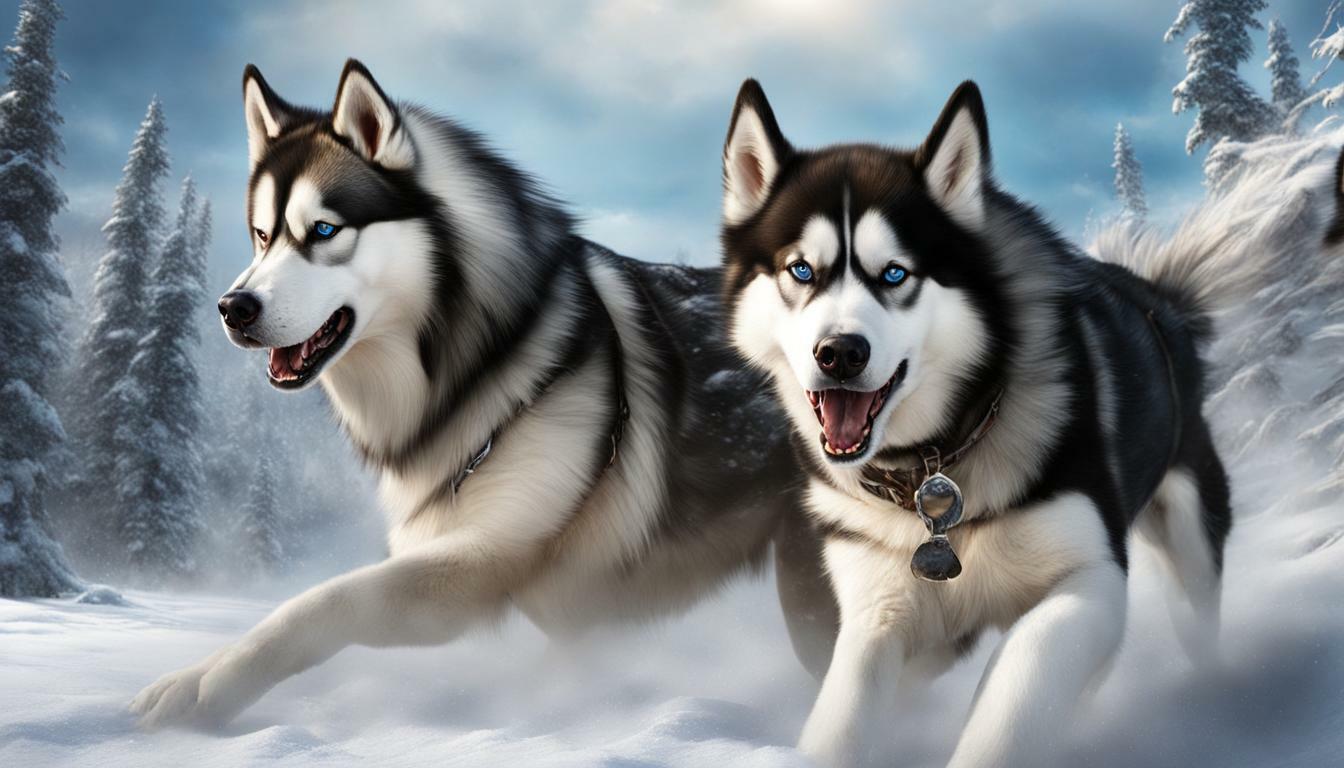When deciding between a Siberian Husky and an Alaskan Malamute, it’s essential to understand the unique characteristics and traits of each breed. While these two breeds share some similarities, such as their origins in Arctic areas, thick double coats, and sled pulling abilities, there are distinct differences that potential owners should be aware of.
The Siberian Husky originated in Siberia and was bred to pull light loads over long distances. They are smaller and lighter, weighing between 35-60 pounds. In contrast, the Alaskan Malamute originated in Alaska and was bred to pull heavy loads over short distances. They are larger and heavier, weighing between 70-85 pounds.
Both breeds have a shared love of running, but Siberian Huskies are known to be more prone to escaping. They are friendly and tend to love their entire family. On the other hand, Alaskan Malamutes are more focused on their people. Additionally, Alaskan Malamutes have curled tails, while Siberian Huskies have tails that hang down. Malamutes also have a wider range of coat colors, while Huskies have more patterns. Siberian Huskies tend to have blue eyes, while Alaskan Malamutes usually have brown eyes.
It’s important to note that both breeds are prone to certain health issues, including hip dysplasia, eye problems, and polyneuropathy. Therefore, regular vet check-ups and proper care are necessary for the well-being of these dogs. Consistent training, exercise, and attention are also crucial for both breeds to thrive.
When choosing between a Siberian Husky and an Alaskan Malamute, potential owners should take into consideration their lifestyle, living situation, and personal preferences. Researching and understanding the characteristics and needs of each breed can help make an informed decision that will ensure a happy and fulfilling life for both the owner and the dog.
Key Takeaways:
- Siberian Huskies and Alaskan Malamutes have distinct differences in their origins, physical traits, and temperaments
- Siberian Huskies are smaller, lighter, and more prone to escaping, while Alaskan Malamutes are larger, heavier, and more focused on their people
- Alaskan Malamutes have curled tails, while Siberian Huskies have tails that hang down
- Siberian Huskies tend to have blue eyes, while Alaskan Malamutes usually have brown eyes
- Both breeds require consistent training, exercise, and attention, and are prone to certain health issues
The Siberian Husky and Alaskan Malamute have distinct origins, with each breed originating in different regions and serving specific purposes. The Siberian Husky hails from the cold climates of Siberia and was bred by the Chukchi people to pull light loads over long distances. Their endurance and ability to withstand harsh weather conditions made them ideal for transporting goods and people across vast icy terrains. These intelligent and hardworking dogs were also known for their friendly and gentle nature.
On the other hand, the Alaskan Malamute originates from Alaska and was primarily used by the native Inuit people for pulling heavy loads over shorter distances. These powerful dogs were crucial for transportation and hunting in the Arctic region. With their muscular build and strong work ethic, they were able to carry heavy loads through snow-covered landscapes. Despite their robust appearance, Alaskan Malamutes are known for their affectionate and loyal nature, making them excellent family dogs.
Both breeds share a common history of being sled dogs and have contributed significantly to the Arctic way of life. Their strength, endurance, and ability to thrive in extreme conditions have earned them a place in the hearts of dog lovers around the world.
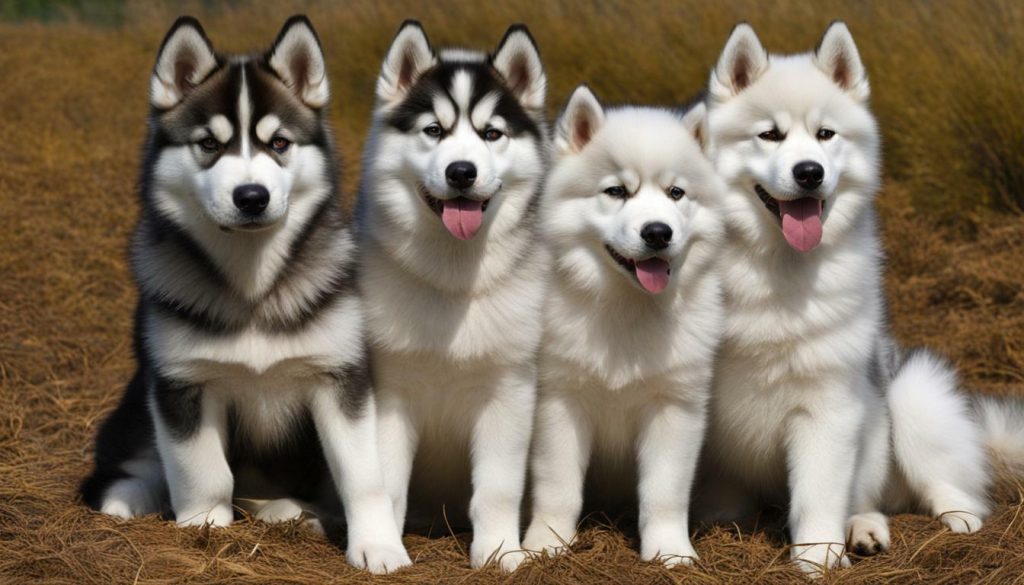
Now that we have explored the origins and background of the Siberian Husky and Alaskan Malamute, let’s dive deeper into their distinguishing physical traits, temperaments, exercise needs, grooming requirements, lifespan, health concerns, training and socialization needs, family compatibility, and ultimately, how to choose the right breed for you.
Physical Traits
Siberian Huskies and Alaskan Malamutes possess notable physical traits that set them apart from each other. These traits contribute to their distinct appearances and abilities. Siberian Huskies are known for their sleek and athletic build. They have a medium-sized frame, weighing between 35 and 60 pounds. Their coats are thick and double-layered, providing insulation against extreme cold weather. These coats come in a variety of colors and patterns, including black, white, gray, and red. Their eyes are often strikingly blue, adding to their captivating presence.
On the other hand, Alaskan Malamutes are larger and heavier, weighing between 70 and 85 pounds. They have a robust and powerful build, with a broad chest and strong muscles. Malamutes have a dense and coarse outer coat, which helps protect them from harsh weather conditions. They come in a wider range of coat colors, including shades of white, gray, black, and sable. One distinct feature of Alaskan Malamutes is their curled tails, which rest over their back, in contrast to the straight tails of Siberian Huskies that hang down.

Comparison of Physical Traits
To better understand the physical differences between Siberian Huskies and Alaskan Malamutes, let’s take a closer look at their key characteristics:
| Traits | Siberian Husky | Alaskan Malamute |
|---|---|---|
| Size | Medium-sized | Large-sized |
| Weight | 35-60 pounds | 70-85 pounds |
| Coat | Thick and double-layered, various colors and patterns | Dense and coarse, wider range of colors |
| Eyes | Often blue | Mostly brown |
| Tail | Straight, hanging down | Curled, resting over the back |
Despite these differences, both breeds possess remarkable physical traits that make them well-suited for their respective environments and tasks. These traits contribute to their charm and appeal, making Siberian Huskies and Alaskan Malamutes beloved companions and working dogs around the world.
Temperament and Personality
While both breeds have their own unique temperaments, Siberian Huskies and Alaskan Malamutes differ in their overall personality traits. Siberian Huskies are known for their friendly and sociable nature. They love being around people, including children, and are generally good with other pets. Their playful and energetic demeanor makes them great companions for active families.
On the other hand, Alaskan Malamutes tend to be more independent and reserved. They are typically loyal to their own family members but can be aloof around strangers. Malamutes have a strong pack mentality and may display dominant behavior if not properly trained and socialized. However, with the right guidance, they can be gentle and affectionate towards their loved ones.
It’s important to note that both breeds have high energy levels and require plenty of exercise to thrive. Siberian Huskies have a strong instinct to run and explore, which can lead to wandering if not properly contained. They may also have a mischievous side and test boundaries. Alaskan Malamutes, although less prone to escaping, still need regular physical activity to keep them mentally and physically stimulated.
When it comes to choosing between a Siberian Husky and an Alaskan Malamute, consider your own lifestyle and preferences. If you’re looking for a sociable and outgoing companion who enjoys being part of the family, a Siberian Husky may be the right fit for you. However, if you prefer a more independent and reserved dog with a strong loyalty to their own pack, an Alaskan Malamute might be a better choice. Ultimately, both breeds can make wonderful pets with the right training, care, and attention.
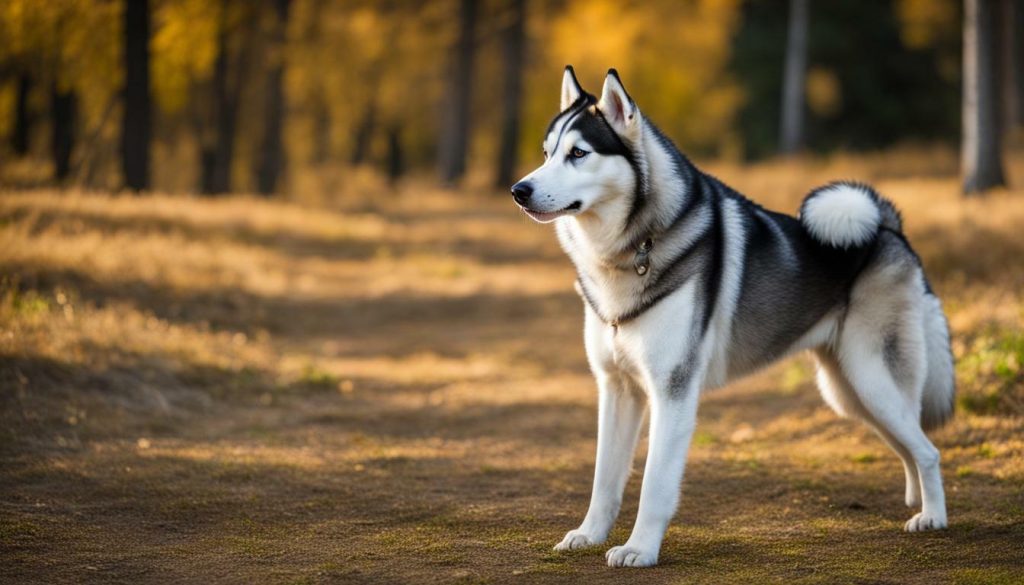
Both Siberian Huskies and Alaskan Malamutes require regular exercise, but their specific exercise needs vary. These breeds have high energy levels and a natural instinct for physical activity. Engaging in regular exercise is crucial for their mental and physical well-being.
Siberian Huskies, with their smaller size and lighter build, thrive on long-distance running and enjoy being active. They are known for their endurance and agility, making them ideal companions for activities like hiking, jogging, or even participating in dog sports such as agility courses. Providing them with at least 60 minutes of vigorous exercise per day helps keep them mentally stimulated and physically fit.
On the other hand, Alaskan Malamutes, being larger and heavier, require more moderate exercise due to their size and strength. While they also appreciate daily walks and runs, they are better suited for activities that involve strength and pulling, such as carting or sledding. Malamutes should have a minimum of 30 to 60 minutes of exercise each day to prevent them from becoming bored or destructive.
| Siberian Husky | Alaskan Malamute | |
|---|---|---|
| Size | 35-60 pounds | 70-85 pounds |
| Exercise Time | 60 minutes per day | 30-60 minutes per day |
| Recommended Activities | Hiking, jogging, dog sports | Carting, sledding, moderate exercise |
It is important to note that exercise alone is not sufficient to meet the needs of these breeds. Mental stimulation is just as vital. Incorporating interactive toys, puzzles, or training sessions into their routine helps challenge their intelligence and prevents them from becoming bored or engaging in destructive behavior.
Remember to consider your own lifestyle and energy levels when choosing between a Siberian Husky or Alaskan Malamute. Their exercise needs should align with your ability to provide them with the necessary physical and mental stimulation. Ultimately, a well-exercised and stimulated dog is a happy and healthy one.
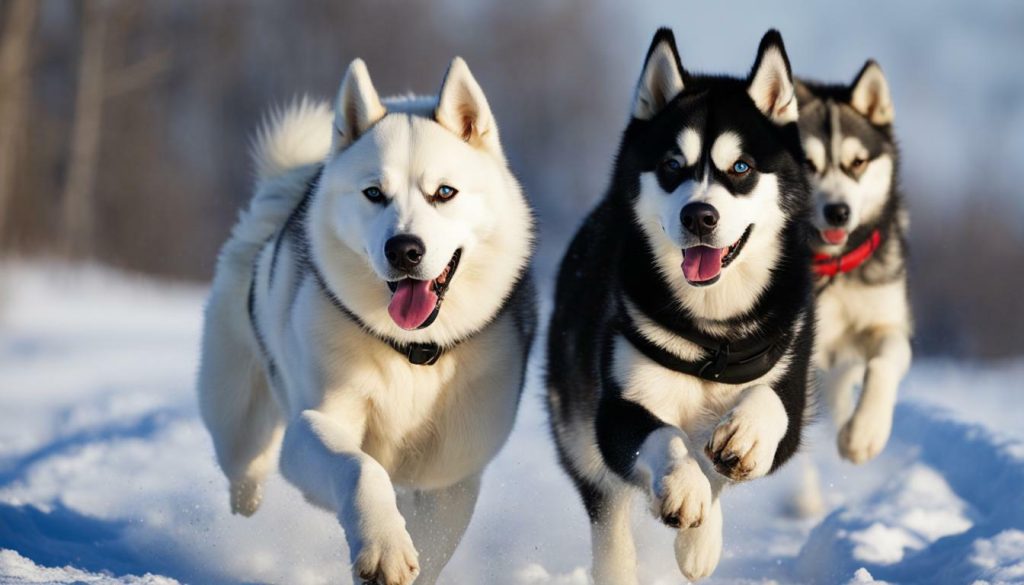
Siberian Huskies and Alaskan Malamutes have distinct coat types, shedding patterns, and grooming needs. Both breeds have thick double coats that provide insulation in cold climates, but there are differences in their coat texture and shedding frequency.
The Siberian Husky has a medium-length, dense coat that requires regular brushing to remove loose fur and prevent matting. Huskies are known for their seasonal shedding, called “blowing their coat,” where they shed their undercoat in large amounts. During this time, daily brushing is necessary to keep their fur under control and minimize shedding in the house. Huskies have a variety of coat colors and patterns, including black, white, gray, and red, with markings such as masks and spots.
The Alaskan Malamute, on the other hand, has a thick, coarse, and oily coat that provides excellent protection against the cold. Malamutes have a longer grooming process compared to Huskies, as their dense fur requires more attention. They shed moderately throughout the year and have two heavy shedding seasons during spring and fall. Regular brushing is essential to keep their coat healthy and free of mats. Malamutes come in various colors, including white, black, gray, and sable, and they often have distinctive facial markings.
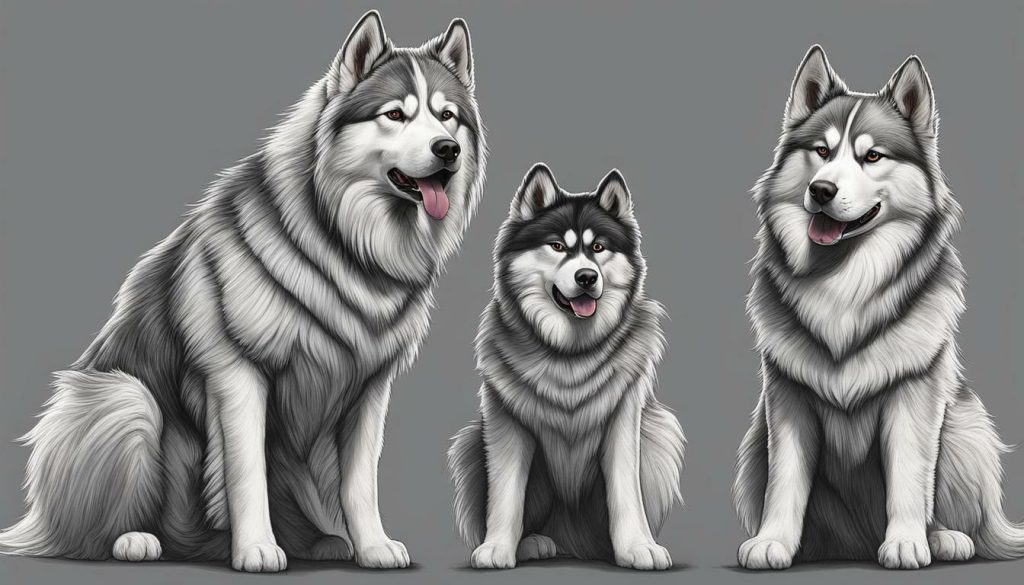
Grooming for both breeds includes regular nail trims, ear cleaning, and dental care. Additionally, bathing should only be done when necessary to avoid stripping away the natural oils that protect their skin. It’s important to note that both Siberian Huskies and Alaskan Malamutes are heavy shedders, so potential owners should be prepared to dedicate time and effort to grooming and managing loose fur in their homes.
In summary, while Siberian Huskies and Alaskan Malamutes have similar double coats, their grooming needs and shedding patterns differ. Huskies have a medium-length coat that requires regular brushing, especially during shedding seasons. Malamutes have a longer, coarse coat that requires more grooming attention to prevent mats and tangles. Both breeds shed heavily, so regular grooming and maintenance are crucial to keep their coats healthy and their surroundings clean.
Lifespan and Health Concerns
Understanding the potential lifespan and health issues of Siberian Huskies and Alaskan Malamutes is crucial for responsible pet ownership. Both breeds have an average lifespan of 10-14 years, but it’s important to note that individual dogs may have shorter or longer lifespans depending on various factors such as genetics, diet, exercise, and overall healthcare.
When it comes to health concerns, both breeds are prone to certain conditions. Siberian Huskies can be prone to hip dysplasia, a common joint problem that can cause pain and mobility issues. They are also at risk for eye problems such as cataracts and progressive retinal atrophy. Alaskan Malamutes, on the other hand, may be predisposed to hip dysplasia, as well as inherited polyneuropathy, a neurological disorder that affects the nerves and can lead to muscle weakness and coordination difficulties.
To ensure the well-being of your Siberian Husky or Alaskan Malamute, regular veterinary check-ups and preventive care are essential. This includes vaccinations, parasite control, dental care, and a nutritious diet. It is also important to provide them with regular exercise to maintain a healthy weight and keep their muscles and joints strong. Remember to monitor their eyesight and seek veterinary attention if you notice any changes in their vision.
| Common Health Issues | Siberian Husky | Alaskan Malamute |
|---|---|---|
| Hip Dysplasia | ✓ | ✓ |
| Eye Problems | ✓ | – |
| Polyneuropathy | – | ✓ |
It’s important to remember that responsible pet ownership also includes providing a loving and stimulating environment, as well as addressing any behavioral concerns through appropriate training and socialization. These are important factors in ensuring the overall well-being and happiness of your Siberian Husky or Alaskan Malamute.
By being aware of the potential health issues and taking proactive steps to address them, you can help your canine companion live a fulfilling and healthy life. Consult with your veterinarian for guidance on specific health concerns and preventive measures for your beloved Siberian Husky or Alaskan Malamute.
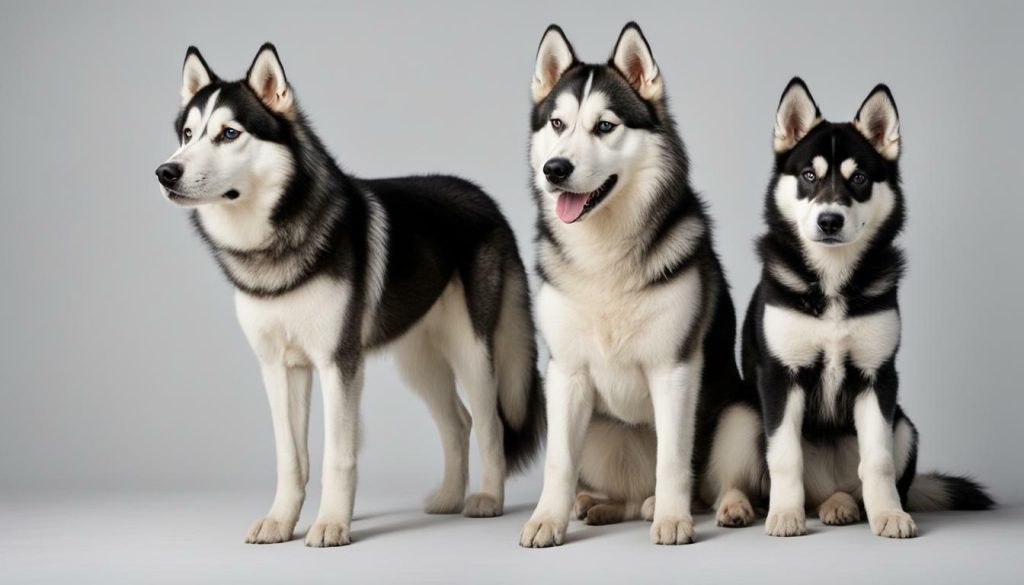
Training and Socialization
Both Siberian Huskies and Alaskan Malamutes are intelligent breeds, but their training and socialization requirements may differ. Siberian Huskies are known for their independent nature and strong prey drive, which can make training a bit more challenging. They are highly intelligent and have a tendency to become bored easily, so it’s important to keep training sessions engaging and varied. Positive reinforcement techniques, such as rewards and treats, work best with Huskies.
Alaskan Malamutes, on the other hand, are highly trainable but can be a bit stubborn at times. They respond well to consistency and firm, yet gentle, handling. Early socialization is crucial for both breeds to ensure they develop into well-rounded, confident dogs. Exposing them to different people, animals, and environments from a young age can help prevent shyness or fearfulness later in life.
It’s important to note that both breeds have a strong instinct to roam and explore, so proper leash training is essential. They should always be kept on a secure leash or in a securely fenced yard to prevent any potential escape attempts. Additionally, both Siberian Huskies and Alaskan Malamutes thrive in an environment that provides mental and physical stimulation. Regular exercise and engaging activities, such as puzzle toys and interactive play, can help keep them mentally stimulated and prevent destructive behaviors.
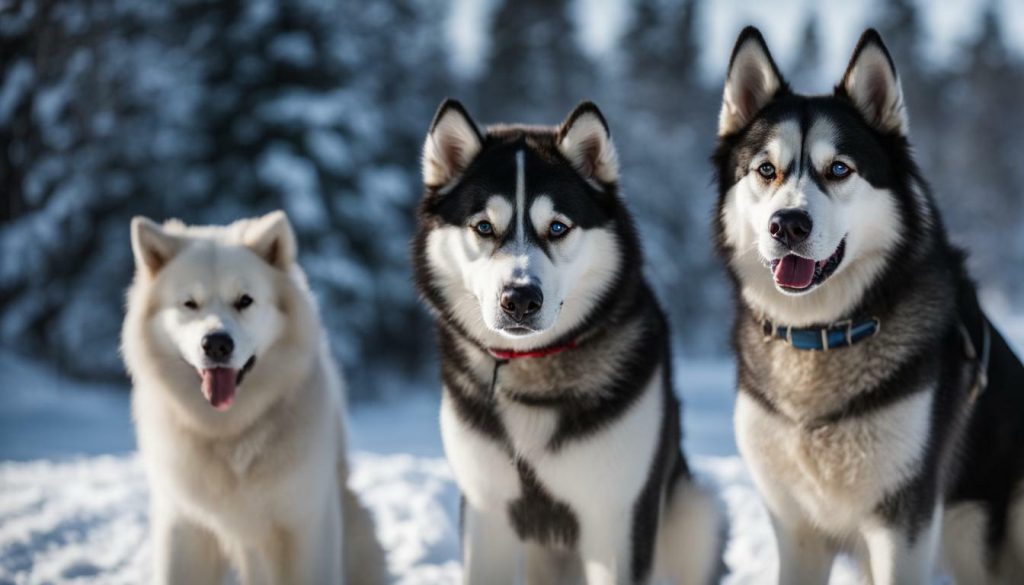
Remember, training and socialization are ongoing processes that require patience, consistency, and positive reinforcement. With the right approach and a commitment to their specific needs, both Siberian Huskies and Alaskan Malamutes can thrive as well-behaved and happy companions.
Family Compatibility
When considering a Siberian Husky or Alaskan Malamute as a family pet, it’s important to understand their compatibility with children and other animals. Both breeds have a reputation for being friendly and affectionate, making them suitable companions for families.
Siberian Huskies are known for their gentle and playful nature, making them great playmates for children. They have a high energy level and love to be involved in family activities. However, their high prey drive and independent nature may require supervision and proper training when interacting with smaller pets, such as cats or rabbits.
On the other hand, Alaskan Malamutes are loyal and protective of their families. They tend to have a calm and gentle demeanor, which makes them excellent around children. However, their size and strength may require caution and supervision when interacting with younger kids. It is essential to teach children how to properly interact with larger dogs to avoid any accidents.
It’s important to introduce both breeds to children and other pets early on and provide proper socialization to ensure a positive and harmonious relationship. With the right training, both Siberian Huskies and Alaskan Malamutes can be loving and devoted family pets.
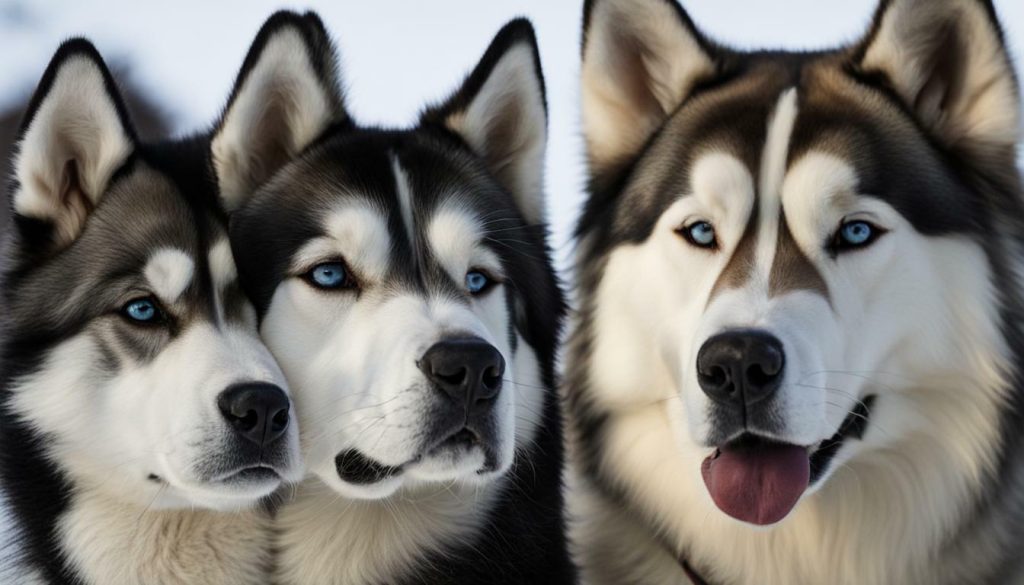
| Siberian Husky | Alaskan Malamute | |
|---|---|---|
| Size | Medium | Large |
| Weight | 35-60 pounds | 70-85 pounds |
| Temperament | Friendly, playful, independent | Loyal, protective, calm |
| Exercise Needs | High | Moderate |
| Coat | Double coat with various patterns | Double coat with curled tail |
| Health Concerns | Hip dysplasia, eye problems, polyneuropathy | Hip dysplasia, eye problems, polyneuropathy |
Choosing the Right Breed for You
Making an informed decision between a Siberian Husky and an Alaskan Malamute depends on various factors that align with your lifestyle and preferences. Both breeds have unique characteristics that may appeal to different individuals. Here are some key considerations to help you choose the right breed:
- Activity Level: Siberian Huskies and Alaskan Malamutes are active and energetic breeds that require ample exercise. However, Huskies have higher energy levels and a stronger desire to run. If you enjoy long runs or have a spacious yard for your dog to roam, a Husky may be a good fit. On the other hand, if you prefer shorter walks or have a more moderate activity level, a Malamute may be a better choice.
- Size and Strength: Consider the size and strength of the breed that suits your living situation. Alaskan Malamutes are larger and heavier, requiring more space and a secure environment. Huskies, being lighter and smaller, are more suitable for apartments or homes with limited space.
- Temperament: Both breeds are known for their friendly and sociable nature, but there are subtle differences. Siberian Huskies are generally more outgoing and affectionate towards everyone, including strangers. Alaskan Malamutes, on the other hand, tend to be more reserved and devoted to their family members.
It is important to note that both breeds require consistent training, socialization, and mental stimulation. They thrive in households where they receive proper attention and interaction from their owners. Additionally, grooming needs should be considered. Huskies have a tendency to shed more and require regular brushing, while Malamutes have a thicker coat that needs regular maintenance to prevent matting.
Before making a decision, spend time with both breeds, if possible, to get a sense of their personalities and requirements. Consider reaching out to reputable breeders or rescue organizations to learn more about each breed’s specific needs. By carefully evaluating your lifestyle and preferences, you can make an informed decision that will ensure a lifelong bond with your new furry companion.
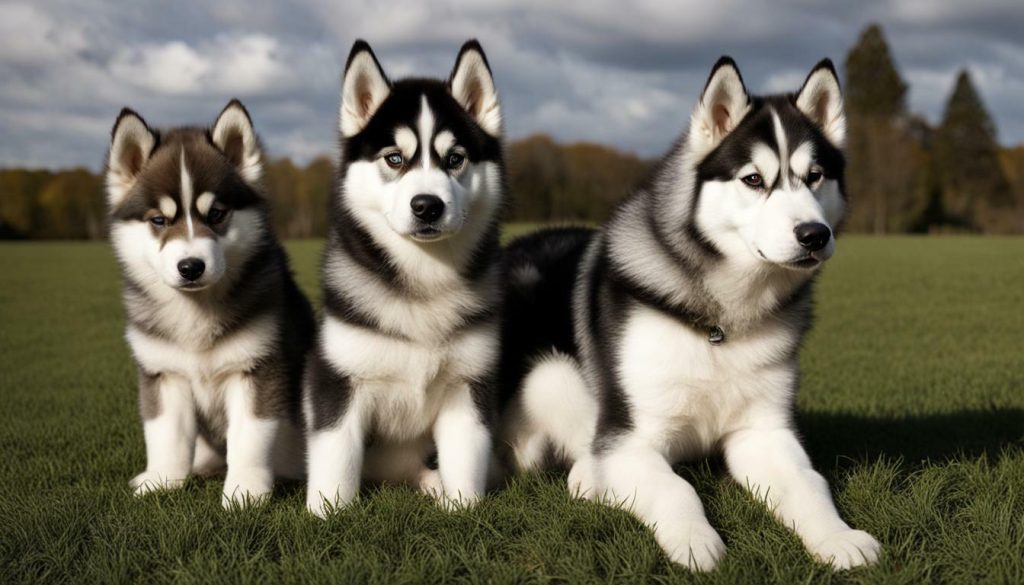
Understanding the distinct characteristics and traits of Siberian Huskies and Alaskan Malamutes is essential in determining which breed suits your needs and preferences best. These two breeds may have some similarities, such as their origins in Arctic areas, thick double coats, and sled pulling abilities, but they also have notable differences.
The Siberian Husky, originating from Siberia, was bred to pull light loads over long distances. Weighing between 35-60 pounds, they are smaller and lighter compared to the Alaskan Malamute. Siberian Huskies have a friendly and playful temperament, often referred to as “velcro dogs” due to their love for the whole family. However, they are known to have a tendency to escape, so proper fencing and supervision are crucial.
In contrast, the Alaskan Malamute, originating from Alaska, was bred to pull heavy loads over short distances. Weighing between 70-85 pounds, they are larger and heavier than Siberian Huskies. Alaskan Malamutes are more focused on their people and tend to be independent and strong-willed. They require consistent and patient training to ensure they become well-rounded companions.
Appearance-wise, Alaskan Malamutes have curled tails, while Siberian Huskies have tails that hang down. Malamutes have a wider range of coat colors, including white, gray, black, and red, while Huskies have more patterns, such as sable, agouti, and piebald. Siberian Huskies often have striking blue eyes, while Alaskan Malamutes usually have brown eyes.
Both breeds share certain health concerns, including hip dysplasia, eye problems, and polyneuropathy. Regular veterinary check-ups and a well-balanced diet are essential in maintaining their overall health and well-being. Additionally, both Siberian Huskies and Alaskan Malamutes require consistent exercise, mental stimulation, and attention to thrive. They are active breeds with a love for running, so daily walks and playtime are a must.
Before making a decision, it’s important to thoroughly research and understand the needs and characteristics of each breed. Consider factors such as your lifestyle, living situation, and personal preferences. Whether you’re looking for a friendly, family-oriented companion or a more independent and strong-willed partner, both Siberian Huskies and Alaskan Malamutes have unique qualities that can make them wonderful additions to the right home. Choose wisely, and enjoy the adventures that come with owning one of these remarkable Arctic breeds.
FAQ
Q: Are Siberian Huskies and Alaskan Malamutes the same breed?
A: No, they are two distinct breeds with similar origins and characteristics.
Q: Where do Siberian Huskies and Alaskan Malamutes originate from?
A: Siberian Huskies originated in Siberia, while Alaskan Malamutes originated in Alaska.
Q: What are the physical differences between Siberian Huskies and Alaskan Malamutes?
A: Siberian Huskies are smaller and lighter, weighing 35-60 pounds, while Alaskan Malamutes are larger and heavier, weighing 70-85 pounds. Alaskan Malamutes have curled tails, while Siberian Huskies have tails that hang down.
Q: How do their temperaments differ?
A: Siberian Huskies are friendlier and love their whole family, while Alaskan Malamutes are more focused on their people.
Q: Do Siberian Huskies or Alaskan Malamutes have more exercise needs?
A: Both breeds have a shared love of running, but Siberian Huskies are more prone to escaping. Both require consistent exercise and attention.
Q: What are the coat and grooming requirements of these breeds?
A: Alaskan Malamutes have a wider range of coat colors and require more frequent grooming due to their thicker coats. Siberian Huskies have more patterns and shed heavily twice a year.
Q: Are there any health concerns with these breeds?
A: Both breeds are prone to hip dysplasia, eye problems, and polyneuropathy. Regular vet check-ups are recommended.
Q: How trainable are Siberian Huskies and Alaskan Malamutes?
A: Both breeds are intelligent and can be trained, but consistency and positive reinforcement are key. Siberian Huskies can be more independent and stubborn.
Q: Are Siberian Huskies and Alaskan Malamutes good with families?
A: Siberian Huskies are generally friendly and love their whole family, including children. Alaskan Malamutes are also good with families but are more focused on their people.
Q: How do I choose the right breed for me?
A: Consider your lifestyle, living situation, and personal preferences. Research both breeds thoroughly before making a decision.
